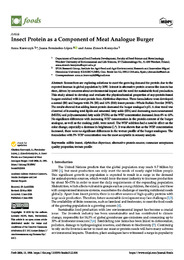Please use this identifier to cite or link to this item:
https://hdl.handle.net/11000/35000Full metadata record
| DC Field | Value | Language |
|---|---|---|
| dc.contributor.author | Krawczyk, Anna | - |
| dc.contributor.author | Fernandez-Lopez, Juana | - |
| dc.contributor.author | Zimoch-Korzycka, Anna | - |
| dc.contributor.other | Departamentos de la UMH::Tecnología Agroalimentaria | es_ES |
| dc.date.accessioned | 2025-01-20T09:29:51Z | - |
| dc.date.available | 2025-01-20T09:29:51Z | - |
| dc.date.created | 2024-06-08 | - |
| dc.identifier.citation | Foods 2024, 13(12), 1806 | es_ES |
| dc.identifier.issn | 2304-8158 | - |
| dc.identifier.uri | https://hdl.handle.net/11000/35000 | - |
| dc.description.abstract | Researchers are exploring solutions to meet the growing demand for protein due to the expected increase in global population by 2050. Interest in alternative protein sources like insects has risen, driven by concerns about environmental impact and the need for sustainable food production. This study aimed to develop and evaluate the physicochemical properties of soy-protein-based burgers enriched with insect protein from Alphitobius diaperinus. Three formulations were developed: a control (B0) and burgers with 5% (B5) and 10% (B10) insect protein—Whole Buffalo Powder (WBP). The results showed that adding insect protein decreased the burger analogue’s pH. A clear trend was observed of increasing total lipids and saturated fatty acids (SFA) and decreasing monounsaturated (MUFA) and polyunsaturated fatty acids (PUFA) as the WBP concentration increased from 0% to 10%. No significant differences with increasing WBP concentration in the protein content of the burger analogue, as well as the cooking yield, were noted. The WBP addition had a notable effect on the color change, especially a decrease in brightness (L*). It was shown that as the WBP concentration increased, there were no significant differences in the texture profile of the burger analogues. The formulation with 5% WBP concentration was the most acceptable in sensory analysis | es_ES |
| dc.format | application/pdf | es_ES |
| dc.format.extent | 15 | es_ES |
| dc.language.iso | eng | es_ES |
| dc.publisher | MDPI | es_ES |
| dc.rights | info:eu-repo/semantics/openAccess | es_ES |
| dc.rights | Attribution-NonCommercial-NoDerivatives 4.0 Internacional | * |
| dc.rights.uri | http://creativecommons.org/licenses/by-nc-nd/4.0/ | * |
| dc.subject | Edible insects | es_ES |
| dc.subject | Alphitobius diaperinus | es_ES |
| dc.subject | Alternative protein source | es_ES |
| dc.subject | Consumer acceptance | es_ES |
| dc.subject | Quality properties | es_ES |
| dc.subject | Texture profile | es_ES |
| dc.title | Insect Protein as a Component of Meat Analogue Burger | es_ES |
| dc.type | info:eu-repo/semantics/article | es_ES |
| dc.relation.publisherversion | https://doi.org/10.3390/foods13121806 | es_ES |

View/Open:
Insect Protein as a Component of Meat Analogue Burger.pdf
1,23 MB
Adobe PDF
Share:
.png)
